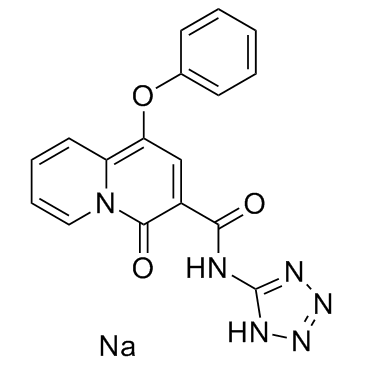Quinotolast sodium
Modify Date: 2024-01-08 16:16:28

Quinotolast sodium structure
|
Common Name | Quinotolast sodium | ||
|---|---|---|---|---|
| CAS Number | 101193-62-8 | Molecular Weight | 371.30500 | |
| Density | N/A | Boiling Point | N/A | |
| Molecular Formula | C17H12N6NaO3 | Melting Point | N/A | |
| MSDS | N/A | Flash Point | N/A | |
Use of Quinotolast sodiumQuinotolast sodium in the concentration range of 1-100 μg/mL inhibits histamine, LTC4 and PGD2 release in a concentration-dependent manner. |
| Name | sodium N-(1H-tetrazol-5-yl)-1-phenoxy-4H-quinolizin-4-one-3-carboxamide |
|---|---|
| Synonym | More Synonyms |
| Description | Quinotolast sodium in the concentration range of 1-100 μg/mL inhibits histamine, LTC4 and PGD2 release in a concentration-dependent manner. |
|---|---|
| Related Catalog | |
| Target |
Histamine LTC4 PGD2 |
| In Vitro | Quinotolast inhibits the release of histamine and the generation of leukotriene (LT) C4 and prostaglandin (PG) D2 from dispersed human lung cells. Quinotolast (100 μg/mL) significantly inhibits PGD2 and LTC4 release. Quinotolast inhibits PGD2 release by 100% and LTC4 release by 54%. The inhibitory effect of Quinotolast on histamine release from dispersed lung cells is largely independent of the preincubation period, no tachyphylaxis being observed. Quinotolast shows a significant inhibition of inflammatory mediators from human dispersed lung cells[1]. Quinotolast also shows strong inhibitory effects on histamine and peptide leukotrienes release from guinea pig lung fragments or mouse cultured mast cells. Quinotolast concentration-dependently inhibits pLTs release from cultured mast cells. The IC50 value for Quinotolast is 0.72 μg/mL[2]. |
| In Vivo | Quinotolast potently inhibits such type I allergic reactions as passive cutaneous anaphylaxis (PCA) and anaphylactic bronchoconstriction in rats by both intravenous and oral dosing. When Quinotolast is given i.v. to rats, Quinotolast, dose-dependently inhibits PCA. The doses of Quinotolast required to inhibit the reaction by 50% (ED50) is 0.0063 mg/kg. Given p.o., Quinotolast inhibits the reaction. ED50 value for Quinotolast is 0.0081 mg/kg. Although almost complete inhibition is observed with Quinotolast at a dose of 0.32 mg/kg, its effect is slightly attenuated at a dose of 1 mg/kg[2]. |
| Cell Assay | Mast cells are obtained after the culture of bone marrow cells from the femurs of female BDF1 mice in the presence of conditioned medium from WEHI-3 cells containing interleukin 3. The cells are suspended with Tyrode's buffer (137 mM NaCI, 2.7 mM KC1, 1.8 mM CaCl2, 1 mM MgCl2, 0.4 mM NaH2PO4, 11.9 mM NaHCO3, 5.6 mM glucose) containing 0.1% gelatin and are sensitized with mouse monoclonal anti-DNP IgE (50 μg/106 cells). Then the cells are washed and resuspended with Tyrode's buffer containing 0.25% BSA. The cells (2×106 cells) are incubated for 5 min at37°C and challenged with TNP-BSA (2 ng BSA/mL). Quinotolast (0.1, 1, 10, 100 ug/mL) is added to the reaction tube simultaneously with the antigen. Ten minutes later, the reaction is stopped by the addition of EDTA (2.7 mM). pLTs in the cell supernatant sre quantified as immunoreactive leukotriene C4 (iLTC4) with a leukotriene C4/D4/E4[3H] assay system. % Inhibition is calculated in each experiment from the amount of immunoreactive leukotriene C4 (iLTC4)[2]. |
| Animal Admin | Rats [2] Rats (8 week-old) are used. To study the presence of tachyphylaxis by Quinotolast, Quinotolast (0.001, 0.01, 0.1, 1,10 and 100 mg/kg) is given i.v. in a large dose 30 min before challenge, and again at a smaller dose simultaneously with the antigen challenge. |
| References |
| Molecular Formula | C17H12N6NaO3 |
|---|---|
| Molecular Weight | 371.30500 |
| Exact Mass | 371.08700 |
| PSA | 114.27000 |
| LogP | 1.93020 |
| Quinotolast sodium |